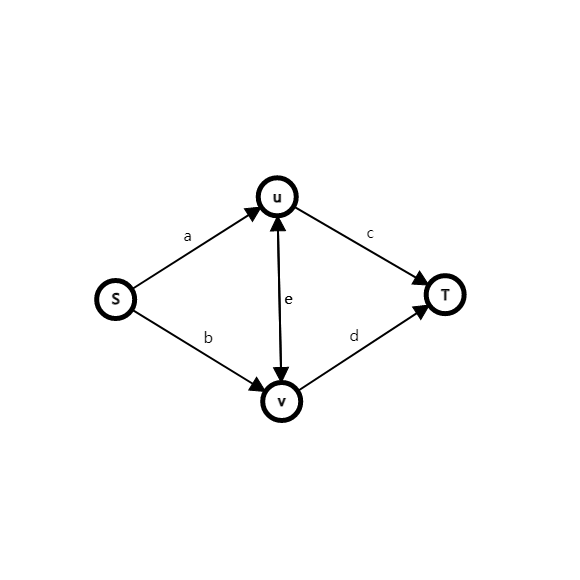[HDU 6598]Harmonious Army
题目
点这里看题目。
分析
首先由于每个士兵有两种选择,因此我们考虑最小割。
但是,与一般的最小割问题不同,不论士兵怎么搭配都会有贡献。为了进一步思考,我们不妨画出常见的基本图:

假如 \(u\in S\) 表示 \(u\) 作为战士, \(u\in S\) 表示 \(u\) 作为法师。
假如我们最初计算了所有贡献 \(A+B+C\) ,那么考察所有的割,应该有如下成立:
\[\begin{cases}
a+b=A+B\\
c+d=B+C\\
a+e+d=A+C\\
b+e+c=A+C
\end{cases}
\]
自然, 4 个方程解不出来 5 个未知数,不过我们可以得到如下解:
\[\begin{cases}
a=b=\frac{A+B}{2}\\
c=d=\frac{B+C}{2}\\
e=\frac{A+C}{2}-B
\end{cases}
\]
对着这组解建图即可。由于分母全是 2 ,因此可以对所有容量扩大两倍建图,最后再除回去。
小结:
这个例子告诉我们,最小割的基本模型中,容量本身是可以被直接代数构造(并提供了一组通解),而没有必要人脑构造。
代码
#include <cstdio>
typedef long long LL;
#define int LL
const LL INF = 0x3f3f3f3f3f3f3f3f;
const int MAXN = 1e5 + 5, MAXM = 1e5 + 5;
template<typename _T>
void read( _T &x )
{
x = 0; char s = getchar(); int f = 1;
while( s < '0' || '9' < s ) { f = 1; if( s == '-' ) f = -1; s = getchar(); }
while( '0' <= s && s <= '9' ) { x = ( x << 3 ) + ( x << 1 ) + ( s - '0' ), s = getchar(); }
x *= f;
}
template<typename _T>
void write( _T x )
{
if( x < 0 ) putchar( '-' ), x = -x;
if( 9 < x ) write( x / 10 );
putchar( x % 10 + '0' );
}
template<typename _T>
_T MIN( const _T a, const _T b )
{
return a < b ? a : b;
}
struct Edge
{
int to, nxt, c;
}Graph[MAXM << 1];
int q[MAXN];
int head[MAXN], dep[MAXN], cur[MAXN];
int N, M, cnt = 1, tot;
void AddEdge( const int from, const int to, const int C )
{
Graph[++ cnt].to = to, Graph[cnt].nxt = head[from];
Graph[cnt].c = C, head[from] = cnt;
}
void AddE( const int from, const int to, const int C ) { AddEdge( from, to, C ), AddEdge( to, from, 0 ); }
bool BFS( const int S, const int T )
{
int h = 1, t = 0, u, v;
for( int i = 1 ; i <= tot ; i ++ ) dep[i] = INF;
dep[q[++ t] = S] = 0;
while( h <= t )
{
u = q[h ++];
for( int i = head[u] ; i ; i = Graph[i].nxt )
if( Graph[i].c && dep[v = Graph[i].to] > dep[u] + 1 )
dep[q[++ t] = v] = dep[u] + 1;
}
return dep[T] < INF;
}
int DFS( const int u, const int lin, const int T )
{
if( u == T ) return lin;
int used = 0, ret, v, c;
for( int &i = cur[u] ; i ; i = Graph[i].nxt )
{
v = Graph[i].to, c = Graph[i].c;
if( dep[v] == dep[u] + 1 && c && ( ret = DFS( v, MIN( lin - used, c ), T ) ) )
{
used += ret, Graph[i].c -= ret, Graph[i ^ 1].c += ret;
if( used == lin ) break;
}
}
if( used < lin ) dep[u] = INF;
return used;
}
int Dinic( const int S, const int T )
{
int f = 0;
while( BFS( S, T ) )
{
for( int i = 1 ; i <= tot ; i ++ ) cur[i] = head[i];
f += DFS( S, INF, T );
}
return f;
}
void Clean()
{
cnt = 1, tot = N;
for( int i = 1 ; i <= tot + 2 ; i ++ )
head[i] = dep[i] = cur[i] = 0;
}
signed main()
{
while( ~ scanf( "%lld %lld", &N, &M ) )
{
Clean(); LL ans = 0;
const int s = ++ tot, t = ++ tot;
for( int i = 1 ; i <= M ; i ++ )
{
int u, v, a, b, c;
read( u ), read( v ), read( a ), read( b ), read( c );
a <<= 1, b <<= 1, c <<= 1;
ans += a + b + c;
AddE( s, u, ( a + b ) >> 1 );
AddE( s, v, ( a + b ) >> 1 );
AddE( u, t, ( b + c ) >> 1 );
AddE( v, t, ( b + c ) >> 1 );
AddE( u, v, ( ( a + c ) >> 1 ) - b );
AddE( v, u, ( ( a + c ) >> 1 ) - b );
}
write( ( ans - Dinic( s, t ) ) >> 1 ), putchar( '\n' );
}
return 0;
}

